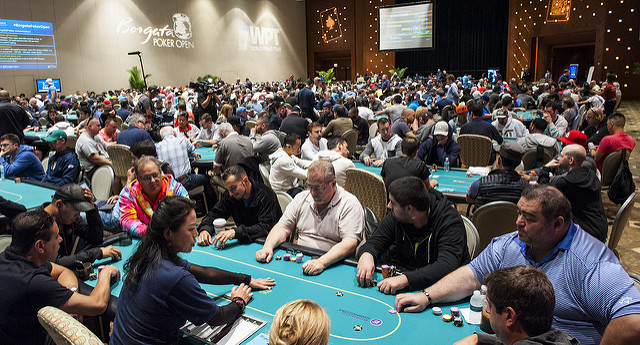Last Saturday I was faced with a dilemma: I was unable to play my usual 1pm $90 tournament. This tournament has a great structure for such a small buy-in: 30,000 chips, 30 minutes blinds, a nice gradual level and ante progression, and most importantly, it gets between 70 and 120 players. Unfortunately, this week other responsibilities restricted my from playing the $90. My only available option was a late afternoon $70 tournament. This one also has 30-minute blinds for the first 9 levels (20 minutes thereafter) and a decent blind structure, but only 15,000 chips, and most critically it only gets 30-40 players on average. Was this really going to be worth my time?
In the $90, the whole final table generally gets paid one way or another (bubbles are paid when there are less than 95 players). Often there is a final 4-5 way chop for near $1,000 each, and sometimes you can make more if you take a top 2 spot. In the$70 tournament if you end up with a $300-$400 take, you’re doing well.
[bctt tweet=”Tournament Fields: How small is too small?” username=”PokerTraining”]
But then again, grinding for 11 hours to get past 80+ players, who are generally higher caliber on average than those in the $70, seems more of a task than having to outlast 30 players over 6 hours. While the payout ratio is the same, there is a lot to account for in the bigger fields. The previous week I got moved to 5 different tables over 10 hours to finish 7th and get $300. In the $70, only 3-4 players are getting paid, maybe a 5th gets their money back and there is no chance of a big payout.
Although logic seemed to dictate that the $70 might not be worth it, the “I want to play” side of my brain won out, as it usually does. When I arrived 20 minutes into the first level and was only the 12th registrant, I knew I was indeed an irredeemable idiot. The tournament swelled to a whopping 26 players in the end, and I made the final table fairly quickly (woohoo!) then to encounter the tightest group of players I had ever seen. This worked great when I was short stacked and able to rob myself back to an above average stack. We played on. Feeling tired near midnight, I proposed an even 6 way chop just to be done with the water torture and walked away with $238 (after tip I netted $150 over buy-in).
I’m not sure this experience furthered my insight into ideal tournament size. For one, my limited window for tournament play will always drive the “I want to play” toddler in me, even in the face of fiscal logic. Second, in perusing Jonathan Little’s new book, Mastering Small Stakes No-Limit Hold’Em, I came across an interesting template for managing your tournament stake.
Little’s premise is that the bigger the field you play, the greater the variability, thus the deeper your stake needs to be. For example, assuming a 30% ROI overall, if you play in single table Sit-N-Go you would need 24 buy-ins in order to comfortably play, whereas for a field of 45 players you would need 69 buy-ins, and at 90 players and you would need 103. Oh my kingdom for 103 buy-ins! For an average field of 1,200 players Little says you need 289 buy-ins. He calculates that downswings of 125 buy-ins over 1,000 events are not uncommon.
So Little’s advice is to stay in small tournaments where you have good results while you build your bankroll. Now the delta between 40 players and 90 may not be as substantial as the jump to 500+ runners, but it still bears some consideration. Still the lure of bigger payouts is awfully tempting.
What about you? Do you have a sweet spot for tournament size? Or some guidelines for your lower and upper limits? I am interested to see how others approach this question.
Like this post? Head on over to the sidebar and subscribe. You will be alerted whenever a new APT blog post goes live!
Follow us on Twitter! [twitter-follow username=”pokertraining” scheme=”dark”]

